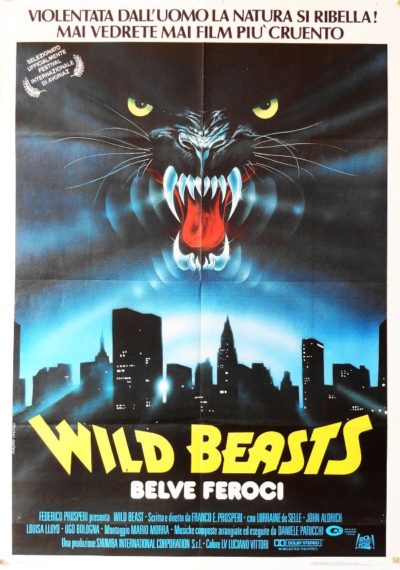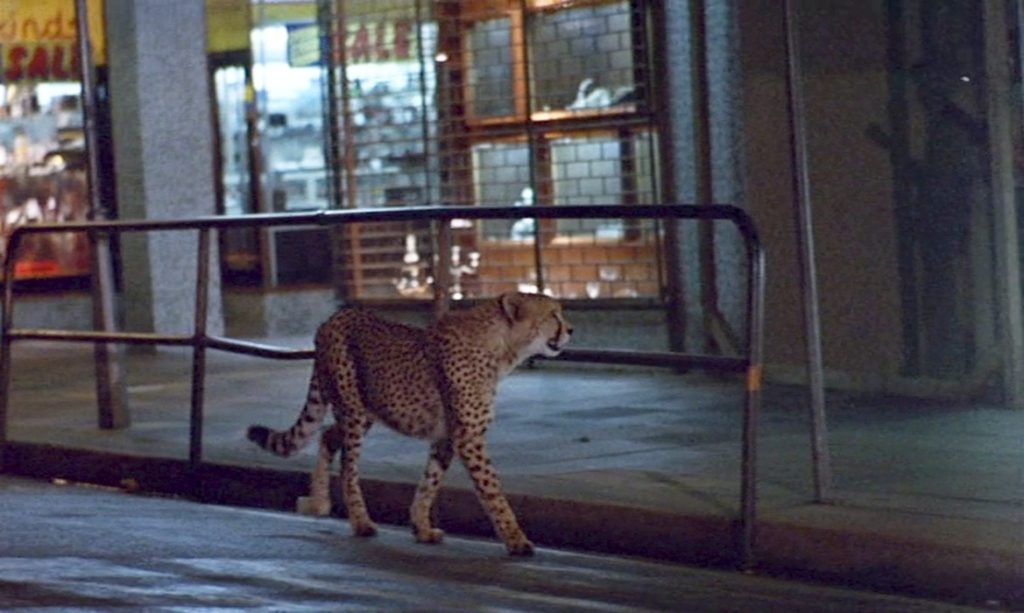
Rating: B-
Dir: Franco E. Prosperi
Star: Lorraine De Selle, Antonio Di Leo, Ugo Bologna, Louisa Lloyd
If you think that Cocaine Bear is the first cinematic example of a drug-crazed animal going on a rampage, let’s talk about this slice of eighties Italian exploitation, directed by one of its more notorious names. Never mind one example of fauna off its face, this delivers an entire zoo’s worth, which gets dosed as a result of a water supply contaminated with PCP. Combine this with a dodgy new security system, and you suddenly have the city streets filled with aggressively inclined lions and tigers and bears. Oh, my! In particular, there’s what can only be described as a PCP polar bear, roaming the corridors of a school where Suzy (Lloyd), daughter of zoo scientist Laura Schwarz (De Selke), is having a ballet lesson.
To be honest, this element is about the only thing here which passes for a coherent plot. There are a few establishing sequences to set the scene as a “Northern European city” (stock and second-unit footage of Frankfurt, though the animal stuff was filmed in South Africa). We meet Laura and zoo vet Rupert Berner (Di Leo), Suzy goes to her dance class and policeman Inspector Nat Braun (Bologna) eats the first of many snacks. Then the drugs kick in, the animals break out, and with one exception, the rest of the film is more or less an extended series of animal attack set pieces. The PCP eventually wears off, the animals calm down, and the film ends.
 That said, the attack sequences are filmed with no small amount of technical aptitude – providing you don’t think about the logic behind them. They’re vicious and bloody, using a combination of real animals and fakes to achieve the illusion. It helps here that, in the early going, we see Berner truly interacting with the zoo inhabitants. Di Leo was, it appears, more of an animal trainer than an actor. What his performance may lack in acting experience, is made up for in him getting up close and personal with the critters. Bringing post-PCP polar bears down off their high and back into captivity, is not something you ever saw Daniel Day-Lewis doing, no matter how many Oscars he may have on his mantelpiece.
That said, the attack sequences are filmed with no small amount of technical aptitude – providing you don’t think about the logic behind them. They’re vicious and bloody, using a combination of real animals and fakes to achieve the illusion. It helps here that, in the early going, we see Berner truly interacting with the zoo inhabitants. Di Leo was, it appears, more of an animal trainer than an actor. What his performance may lack in acting experience, is made up for in him getting up close and personal with the critters. Bringing post-PCP polar bears down off their high and back into captivity, is not something you ever saw Daniel Day-Lewis doing, no matter how many Oscars he may have on his mantelpiece.
There are problems with these elements, and to discuss these, we need to understand Prosperi’s background. Not to be confused with the other Italian director called Franco Prosperi, this one was a pioneer of the “mondo” genre, documentaries which concentrated on sex and violence. He was a director on the 1962 film Mondo Cane, which spawned many imitators – and, bizarrely, got an Oscar nomination in the Best Song category for its theme. His history also includes the incendiary Goodbye Uncle Tom, about race relations in the US, and Wild Beasts has been heavily criticized for some of its treatment of animals. Considering it opens with a cleaver being driven into a horse’s head, this concern is certainly understandable.
I should stress, the horse is already dead and is being chopped up to provide meat for the big cats in the zoo. It’s still unsettling viewing for a society not inclined to view equines as food, even for animals. But there are a number of subsequent moments that don’t appear to allow for that “pre-deceased” defense. Rats are set on fire, and big cats are unleashed on the inhabitants of a slaughterhouse, both apparently taking place for real (the latter may merit a slight pass, considering their likely eventual fate anyway). There are also questions about safety in general. There are some scenes at the school where the polar bear is disturbingly close to the children, with nothing apparently between them. I don’t care how many sharpshooters were carefully positioned, just out of camera range.
Outside such concerns, there are some sequences which are strikingly well-done. The one likely to stick in your head most has a cheetah chasing a VW convertible through deserted streets (below) – apparently accomplished by lashing a chicken to the rear bumper! It’s a master-class in how to edit the implausible, such that it appears to make sense. The attack of a tiger on a tube train (top) is another stand-out, and for sheer grossness, I’d like to add in the moment where an elephant squishes a poor victim’s head like a ripe grape, and the rat attack on the canoodling couple. The scenes involving PCP polar bear are, again, well-constructed: Prosperi’s background in “documentaries” perhaps helps to give these an additional sense of reality.
 I mentioned above the “one exception” to this being an all-you-can-eat buffet of animal attacks. That comes at the end, when Laura reaches her daughter’s school, only to find some of the pupils have fallen victim to the drugs in the water too. This doesn’t actually make any sense. If pushed, I can just about believe that, for some reason, only the zoo’s supply would be contaminated. That it’s limited to the zoo and a school, not apparently nearby, without any other humans being impacted is just a bridge of plausibility too far. And that’s in a movie which includes the immortal line, “No, she’s not crazy – she’s being chased by a cheetah!” Maybe Prosperi is a fan of 1976’s killer kids movie, Who Can Kill a Child?
I mentioned above the “one exception” to this being an all-you-can-eat buffet of animal attacks. That comes at the end, when Laura reaches her daughter’s school, only to find some of the pupils have fallen victim to the drugs in the water too. This doesn’t actually make any sense. If pushed, I can just about believe that, for some reason, only the zoo’s supply would be contaminated. That it’s limited to the zoo and a school, not apparently nearby, without any other humans being impacted is just a bridge of plausibility too far. And that’s in a movie which includes the immortal line, “No, she’s not crazy – she’s being chased by a cheetah!” Maybe Prosperi is a fan of 1976’s killer kids movie, Who Can Kill a Child?
For these reasons – and I haven’t even mentioned the questionable shots of Suzy – it’s safe to say that this is one of those “They couldn’t make it nowadays” films. Or, at least, not in the same way. As the likes of Beast show, animal attacks can now be staged, at least reasonably convincingly, using CGI. From the animal’s point of view, that’s likely a good thing. However, just as Jackie Chan’s stunts are all the more impressive, knowing that he’s actually flinging himself from a clock tower, there’s something which draws the viewer in, knowing that real children are being pursued – albeit in a rather unenthusiastic manner – by a real polar bear. Having Ray Liotta genuinely mauled, is something which Cocaine Bear is just not able to offer.
